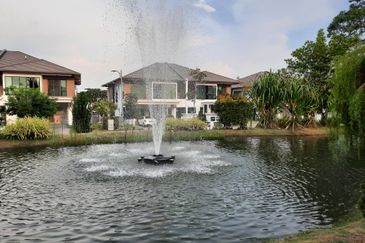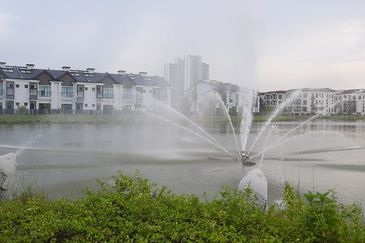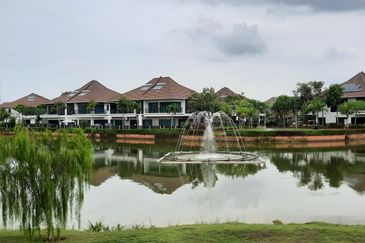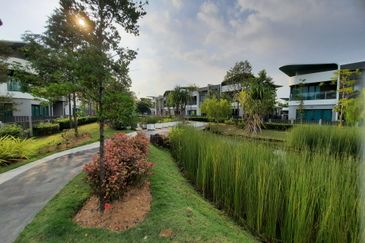WHEN Patrick Lecomte arrived in Singapore in 2009, during the depths of the global financial crisis, companies large and small were desperately slashing costs to stay afloat, with some even cutting their headcount. It was a different story with Singapore's real estate investment trusts (S-REITs), though. Even as the market value of their units crashed in the face of the massive credit crunch and investors were forced to come to their rescue with fresh injections of equity, the external managers of these S-REITs continued collecting their fees.
"When I arrived in 2009, I went to a conference at [the National University of Singapore] and there were some [executives] from the REITs there," he relates. "And, there was this uncle who suddenly stood up and yelled, 'Why are you taking all those fees when I don't have my returns and business is not so good?'"
The lanky, six-foot-tall French scholar with a long list of academic credentials from Europe and the US had come to Singapore to teach real-estate finance at ESSEC Business School. He is currently executive director of the school's Advanced Master in Financial Techniques and Financial Engineering, Asia, a programme he launched and manages. The complaints he heard about S-REITs at that event and elsewhere soon set him thinking whether they were being managed with the interests of investors in mind.
According to Lecomte, there are two things that most concern international investors about S-REITs. The first is whether the fees that REITs pay their external managers properly incentivise the managers to create value for investors. The other bugbear is that S-REITs are often backed by major property companies and there are frequent "related-party transactions [RPTs]" between them. "It is a huge topic for foreign investors in Asia. They don't like RPTs because they think it's a way to get some benefits for the company on the back of the minority unitholders in the REIT," he says.
Lecomte began delving into the sector to discover if the criticisms were valid, engaging the managers of several S-REITs in discussions and studying their practices and performance. He was also commissioned by the Asia Pacific Real Estate Association (APREA) to develop a corporate-governance index based on a scoring framework of best practices for the S-REITs. In June this year, he published the so-called R-Index of Corporate Governance, which compared S-REITs, Malaysian REITs and Japanese REITs.
Lecomte's study seemed to confirm that corporate governance standards at S-REITs still leave a lot to be desired. The R-Index is based on a scoring system that ranges from -11 to +88. Yet, every single S-REIT scored less than the mid-point of 38.5 till 2009. Only in 2010, the latest year for which data is available, did the mean score reach mid-point.
The top three S-REITs in the R-Index for 2010 were CapitaCommercial Trust, CapitaMall Trust and Ascott Residence Trust. They were followed by AIMS AMP Capital Industrial REIT, Ascendas REIT, CDL Hospitality Trust and Frasers Centrepoint Trust, in that order. Lecomte declines to reveal the S-REITs that were at the bottom of the R-Index ranking.
Not surprisingly, the results of Lecomte's study didn't go down well with players in the S-REIT sector. "Sometimes, the basis and context for these rankings need to be properly considered for the specific jurisdiction and situation," says Arthur Lang, chief financial officer of CapitaLand, which has six S-REITs in its corporate stable. A number of other S-REIT players were much less polite than that, according to Lecomte.
Value of good governance
Yet, Lecomte insists that the methodology of his study is sound, and that the results can be usefully applied by the REIT sector to enhance its growth and vitality. In fact, the paper presenting the index methodology received the award for best research in International Real Estate Portfolio Management at the American Real Estate Society's 26th annual meeting in April last year.
The scoring framework for the R-Index includes 27 factors within eight categories of corporate governance. The eight categories listed in order of their weightage on the overall score are: fees (25%), board matters (19%), RPTs (16%), REIT organisation (15%), remuneration matters (8%), audit committee (6%), gearing (6%) and ownership (5%).
Scores are assigned in each category according to a number of factors. For example, if a REIT manager's fee is less than 0.6% of its assets under management (AUM), the score is 1; if it is equal to 0.6% of AUM, the score is 0.5; and if it is greater than 0.6% of AUM, it is zero. The scores are then added up to come up with the overall R-Index score.
While absolute scores for S-REITs seem low, Lecomte says they are actually consistent with some corporate-governance rankings for Singapore-listed companies. In 2012, the average overall NUS Governance and Transparency Index score for Singapore-listed companies was just 34.9, with only 6% of the companies included in the survey scoring more than 50 points out of a possible 100.
What is perhaps more important is how the scores have changed over time and how they correlate with other things. According to Lecomte's studies, the mean R-Index score for S-REITs has gradually improved. It climbed from just 18.5 in 2003 to 23.38 in 2008. It rose a further 32% in 2009, and another 25% in 2010, breaching the mid-point of 38.5. Meanwhile, the standard deviation has been narrowing steadily, Lecomte says. That suggests an improvement and a greater consistency in corporate-governance practices, the result perhaps of more and more S-REITs coming to market.
Lecomte's studies also suggest that some preconceived notions investors might have about S-REITs are actually false. For instance, it apparently isn't true that REITs with external managers related to their sponsors have relatively poor disclosure practices. Nor is it true that interested-party transactions (IPTs) are less likely to create value for REIT investors. In fact, it seems that the close ties between manager and sponsor have made them more careful about how they operate and more willing to make disclosures .
The R-Index also provides a standard of sorts that S-REITs can use as a benchmark to differentiate themselves in the market. For instance, REITs with assets abroad have traditionally been thought to be less transparent. "CapitaRetail China Trust [CRCT] has disproved this," Lecomte says. In fact, CRCT is among the most transparent of the S-REITs. All its fees are reported in its quarterly results, and it provides investors with extensive information about retailing and shopping trends in China, notes Lecomte.
The R-Index might also alert investors to changes in transparency that are not in their favour. For instance, the CapitaLand group recently began disclosing its executive remuneration in wider bands than before. "CapitaLand used to be very good. They gave a small range, but now they have increased the range," Lecomte says. That will have an impact on the R-Index scores of its REITs. "The score depends on the range — S$100,000 (RM250,522) range, S$150,000 range."
That's not to say that REITs might not have a valid reason for their behaviour. "One of the reasons the REITs gave is that remuneration cannot be disclosed because of competition. The good managers will get poached because of competition," Lecomte says. Whatever the trade-offs, having standards for REITs to benchmark themselves against helps improve the overall market, he adds.
How does all this information make a difference to investors? To find out, Lecomte partitioned the S-REITs into two different portfolios, according to whether their corporate-governance scores are above or below the median score and then studied their operating and stock-price performance. He found that there was little correlation between the scores and the S-REITs' operating performance. But the scores did make a difference to their stock-price performance. S-REITs with corporate-governance scores higher than the median delivered stock-price performances that were 1.6 percentage points higher per year than S-REITs with scores below the median.
The way Lecomte sees it, adopting the best practices in transparency, disclosure and governance — reflected in a high R-Index score — attracts investors. And, widespread adoption of these standards would make Singapore an attractive market for REITs to list, further entrenching its leading position in the region. "It's a golden opportunity," Lecomte says. So, what can the S-REITs do to improve their R-Index scores? Are they moving in the right direction?
Manager-fee reform
The largest weight in the R-Index relates to manager fees, making it an obvious area to look at for ways to improve a REIT's corporate-governance standing. It is also an issue that is under increasing scrutiny by investors. Most REITs pay a base fee linked to the size of their portfolios and a performance fee that could be tied to anything from its gross revenue or net property income (NPI) to its distribution per unit (DPU) or stock-price performance.
However, the overall fee structure tends to be overwhelmingly driven by the size of the portfolio more than anything else. That has led to REIT managers being criticised for pursuing asset growth rather than maximising returns for REIT investors.
"As a unitholder, do you care about deposited property? Does it impact your return? Not really," Lecomte says. In his view, REITs should have a fee structure heavily driven by their DPUs rather than the size of their portfolios. "It's a matter of mindset. We have to change the mindset of the sponsors and the manager. They think in terms of property, but you, as a unitholder, don't think like that. Get into the shoes of the unitholders. This is the first thing they should do."
But he stops short of making any hard-and-fast prescriptions. "It should be some kind of total shareholder-type metrics over a few years and related to some measures for unitholders," he says. "It should be up to the unitholders to decide," he adds.
A number of other people with deep knowledge of the S-REIT sector concur with much of what Lecomte says. Eng Seat Moey, managing director and head of asset-backed structured products at DBS Group Holdings, agrees that REITs need to rethink their manager-fee structure. "Have a performance fee, but what do you peg it to? Is gross revenue enough? Not enough. NPI? Not enough, because NPI doesn't take into account your [capital] structure. You should use distributable income," she says.
Eng also suggests that REITs look more closely at their base-fee structure. While it is important for REIT managers to be assured of a base fee to cover their costs and continue with their work, it shouldn't be allowed to inflate in lockstep with the size of a REIT's portfolio. That's because managing an expanded portfolio often doesn't result in higher costs for the manager. "The base fee goes up without your doing anything, which is not right," she says.
Of course, at some point, a larger portfolio might require the manager to take in additional people. Eng suggests that REITs structure their base fees so that they "step up" when their asset size crosses a threshold that increases their managers' running costs. "Our advice now is to have a higher component of performance fee and lower component of fixed fee [that allows for] cost recovery. When you get bigger, you can have an incremental increase in your cost recovery because you need more people to look after the assets," Eng says.
Eng also suggests that REITs relook the property management fees they charge to ensure that they are consistent with the kinds of assets being managed. For instance, managing warehouse properties or offices is less costly and requires less effort than running a shopping mall with heavy foot traffic and frequent special events. "Do you need to do a lot of property management for an industrial REIT? Do you need to do a lot for offices? But for retail, you really need to do a lot of work," Eng says.
Rein in acquisition fees
Perhaps the most contentious of issues facing S-REITs is their frequent acquisition of assets from sponsors. In several instances, the acquisitions are accompanied by some form of financial engineering to boost the near-term yields of the properties being acquired, ensuring the acquisitions are immediately yield-accretive to the REITs, but leaving REIT investors vulnerable to possible disappointment in the future. And, they sometimes require the REITs to tap their investors for financing. On top of that, the REITs are charged fees by their managers for their acquisitions and divestments.
In 4Q2011, shares in K-REIT Asia were severely battered as it acquired an 87.5% stake in Ocean Financial Centre (OFC) from Keppel Land for S$2 billion. The deal came with a five-year rental support of S$170 million, bringing the effective price down to S$1.84 billion and pricing the property at S$2,380 psf. To raise S$985.7 million to part-fund the acquisition, K-REIT announced a 17-for-20 rights issue at 85 cents per unit, or a 17.5% discount to the last traded price on Oct 17, 2011. The announcement was made when units in K-REIT were at S$1.03.
Yet, some REIT sector watchers say the acquisition is working out well. The deal was completed last December and K-REIT's 1H2012 results were stunning. NPI more than doubled to S$59.8 million, owing mainly to income contribution from OFC. Distributable income rose 94.6% y-o-y to S$98.4 million and DPU rose 92.0% to 3.84 cents.
Eng of DBS points out that such RPTs between a REIT and its sponsor are already subject to many checks and balances. Firstly, the property needs to be priced by not one, but two, valuers. An independent financial adviser (IFA) will then make recommendations to the independent directors and unitholders. If the IFA says the valuation is fair, the independent directors are unlikely to recommend against the transaction.
In the case of K-REIT Asia's purchase of OFC, all the correct procedures were followed, according to Eng. She adds that the majority of directors on the board of K-REIT's manager are independent, including its chairman. "Whatever it was, there was a willing buyer and a willing seller," Eng says. What happens when the income support expires? "It's a view you have to take," Eng says. "Will the building be able to command the right rental? It's a judgement call."
Yet, Eng is critical of acquisition and divestment fees of as much as 1% that REITs are charged when those deals are done with their sponsors. In instances where the deal is a RPT, the fee should be halved from 1% to 0.5%, she says. Lecomte agrees that something ought to be done about acquisition and divestment fees. "Acquisitions are highly controversial.
When you think in terms of a normal company, does it get fees when it buys and sells businesses or properties? No," he says. "REIT managers argue they are doing the research on the property, but isn't this part of running the business? The way you should be rewarded is if you are creating value for your shareholders. There is no way you can justify your fees." Should regulators step in to prescribe new standards for REIT manager fees? What impact would that have on Singapore's leading position as a REIT market? What does it all mean for investors?
Change is coming
Eng says it should be up to the investors and REIT managers to determine the appropriate fee structure. The role of the government in this process is to push for greater transparency so that there is broad awareness of what REITs are being charged. "You cannot get the regulator to prescribe the fee, but you can get the regulator to make you disclose your fees," Eng says.
The way she sees it, REITs ought to present the fees they pay in their annual reports in a way that gives investors a clear picture of what is happening. "Put all the acquisitions for the year together and disclose the acquisition fees for the year, since some do many acquisitions," Eng suggests. Then, group all the recurring fees for the year separately, she continues, and break down any fees charged by the manager for development projects in which the REIT is invested.
To be sure, greater disclosure and wider awareness of manager-fee structures might force some REIT managers to become more competitive and perhaps deter some from launching new REITs. But it would ultimately give investors greater confidence in backing the best-managed REITs in the market. "If investors think they are getting value for their money, they won't argue over the fees," Lecomte says.
Already, some REIT managers are voluntarily responding to these calls for reform. In June, Ascendas REIT reduced its property-management fee through an EGM and aligned its leasing-fee compensation with longer leases. Then, on July 27, at an EGM, unitholders of Ascott Residence Trust approved a transaction, part of which involved the sale of Somerset Grand Cairnhill to CapitaLand for S$359 million.
The asset will be redeveloped and then sold back to the REIT for S$405 million in 2017. Under the deal, unitholders of Ascott Residence Trust will pay a 0.5% divestment fee, but the 1% fee for the acquisition of the redeveloped property in 2017 has been waived. If other S-REITs follow in their footsteps, perhaps the mean R-Index score for the local market will keep improving. For Lecomte, and investors too, that would be good news. — The Edge Singapore
This story appeared in The Edge Singapore on Aug 6, 2012.
TOP PICKS BY EDGEPROP

Broadleaf Residences, Hometree
Kota Kemuning, Selangor

Halya @ Daunan Worldwide
Bandar Puncak Alam, Selangor

Bandar Puncak Alam
Bandar Puncak Alam, Selangor

Bandar Puncak Alam
Bandar Puncak Alam, Selangor

Bandar Puncak Alam
Bandar Puncak Alam, Selangor

Lepironia Gardens, Setia Eco Glades
Cyberjaya, Selangor

Isle of Botanica, Setia Eco Glades
Cyberjaya, Selangor

Setia Marina 3, Setia Eco Glades
Cyberjaya, Selangor

Charms of Nusantara, Setia Eco Glades
Cyberjaya, Selangor

Eco Botanic
Iskandar Puteri (Nusajaya), Johor

Liu Li Garden, Setia Eco Glades
Cyberjaya, Selangor

Lepironia Gardens, Setia Eco Glades
Cyberjaya, Selangor

Lepironia Gardens, Setia Eco Glades
Cyberjaya, Selangor

Lepironia Gardens, Setia Eco Glades
Cyberjaya, Selangor







hero.jpg?GPem8xdIFjEDnmfAHjnS.4wbzvW8BrWw)



